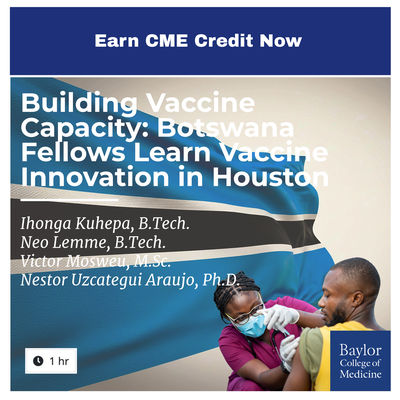Building Vaccine Capacity: Botswana Fellows Learn Vaccine Innovation in Houston
This summary was automatically produced by experimental artificial intelligence (AI)-powered technology. It may contain inaccuracies or omissions; see the full presentation before relying on this information for medical decision-making. If you see a problem, please report it to us here.

Introduction
This document summarizes a lecture detailing a unique collaboration between Texas Children's Hospital (TCH) and the Botswana Ministry of Health, aimed at building vaccine development and manufacturing capacity in Botswana.
The initiative brought four distinguished leaders from Botswana to Houston for intensive training, driven by the critical need to address Africa's reliance on external vaccine supply, a vulnerability starkly exposed by the COVID-19 pandemic.
Context and Motivation
The COVID-19 pandemic highlighted a significant global health disparity, as only 3% of vaccines with African content are manufactured on the African continent. This lack of local manufacturing capacity leaves African nations vulnerable during health crises.
Botswana, recognizing this challenge, is actively promoting technology transfer and manufacturing capabilities within its health sector. Developing in-country vaccine manufacturing capabilities is crucial for responding to pandemics, enhancing diagnostic capabilities, fostering economic development, and achieving social advancement.
The Collaboration and Training Program
The program, anchored by TCH's National School of Tropical Medicine, focused on providing comprehensive academic and hands-on training for the Botswana fellows. The participants included:
- Mr. Victor Mosweu, Deputy Director of Patient Safety and Quality Assurance at Botswana's Ministry of Health, a public health leader with over two decades of experience.
- Ms. Neo Lemme, Medical Scientific Officer at Botswana's National Tuberculosis reference laboratory, an expert in biorisk management and TB diagnostics.
- Ms. Ihonga Kuhepa, with over 20 years of laboratory leadership experience, specializing in malaria diagnostics, epidemic preparedness, and quality assurance.
- They were joined by Dr. Nestor Uzcategui from TCH, a molecular biochemist and Director of the Antigen Discovery and Molecular Biology Unit.
The fellows engaged in weekly rotations, gaining practical experience in diverse areas including discovery and molecular biology processes, formulation, quality control, development, preclinical evaluation, and vaccine registration.
Key Project: Malaria Vaccine Antigen Development
A central part of their training involved a project focused on the development of Plasmodium falciparum Circumsporozoite Protein (CSP) antigens for a malaria vaccine, specifically working with CSP2 and CSP4 constructs. This work showcased the practical application of their learning across the entire vaccine development pipeline:
- Protein Expression and Optimization:
- Fellows learned to prepare genetic constructs using software and introduce them into Pichia expression media via electro-operation.
- They optimized culture conditions, including a glycerol feed phase to increase biomass and subsequent methanol induction for robust protein expression.
- These optimizations led to significant yields, with 40 grams per liter of culture achieved using specific glycerol and methanol rates, and ultimately a purified yield of 300mg/L for both CSP2 and CSP4.
- Downstream Processing and Purification:
- The team utilized advanced purification techniques, including tangential flow chromatography for filtration and concentration, and an automated chromatography system for protein purification.
- Multiple chromatography steps, including cation exchange and size exclusion chromatography, were employed to achieve high purity.
- The purification process successfully yielded 78mg of CSP2 and 88mg of CSP4, demonstrating high purity of 98-99% with low levels of host cell proteins.
- Protein Characterization:
- Thorough characterization determined the biophysical and biochemical properties of the purified proteins. This included analysis of protein content, pH, and SDS-PAGE, which revealed that CSP2 had trace dimer amounts while CSP4 was primarily monomeric.
- Advanced techniques like High Performance Liquid Chromatography (HPLC) and Dynamic Light Scattering (DLS) were used to confirm purity and particle size, despite observed experimental molecular weights being higher than theoretical values.
- Immunogenicity Testing:
- A critical achievement was demonstrating the strong antibody recognition of the CSP fragments (CSP2, CSP4, and CSP0) in human serum from individuals infected with Plasmodium falciparum malaria.
- Specifically, CSP2 fragment showed elevated recognition in malaria-positive serum samples compared to non-traveler controls, a finding that supports the further development of these CSP constructs for vaccine applications.
Impact on Fellows and Botswana's Capacity
The fellows reported gaining an "amazing magnitude of research skills" and acquiring advanced technical knowledge.
They enhanced their expertise, made valuable professional connections for future collaborations, and significantly improved their scientific communication skills. This experience, which pushed them out of their comfort zones, broadened their understanding of molecular biology – the foundation of vaccine development – and strengthened their motivation to contribute to humanity.
Conclusion
This collaboration represents a significant step towards strengthening local capacity for vaccine development and manufacturing in Botswana. The skills, knowledge, and practical experience gained by the fellows are directly applicable to building Botswana's capability to address future health challenges, reducing reliance on external resources, and fostering self-sufficiency in public health.
The project's success in developing and characterizing malaria vaccine candidates further underscores the practical benefits of such international partnerships. The Ministry of Health, Baylor University, and Texas Children's Hospital were acknowledged for their pivotal support in this endeavor.
Artificial intelligence (AI) was used to transcribe the presentation’s contents and create a summary of the information contained in the presentation. This is an experimental process, and while we strive for accuracy, AI-generated content may not always be perfect and could contain errors. This summary has not been reviewed by the presenter to guarantee completeness or correctness of the content, so it should not be used for medical decision-making without reviewing the original presentation. If you have feedback, questions, or concerns, please contact us here.